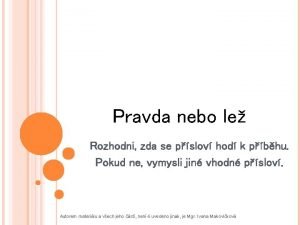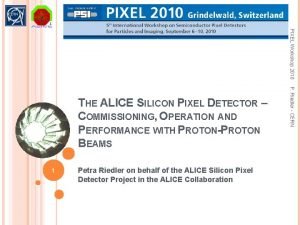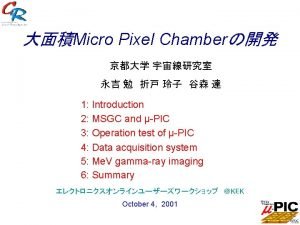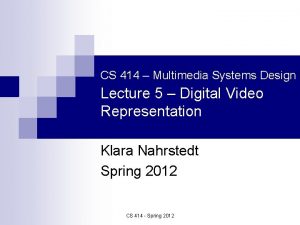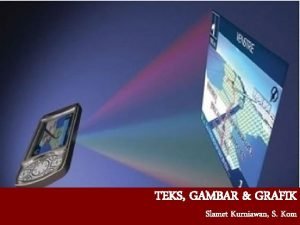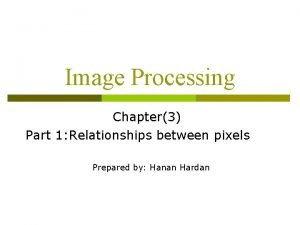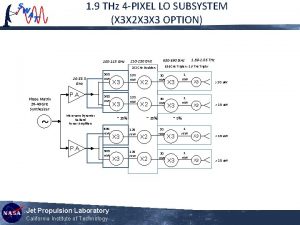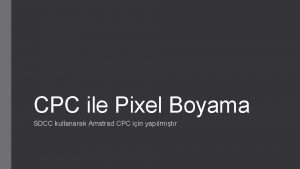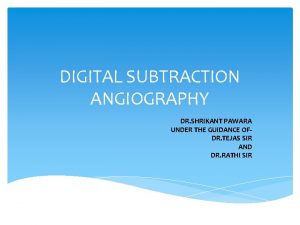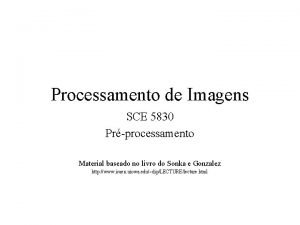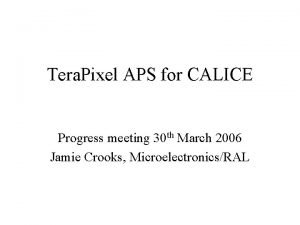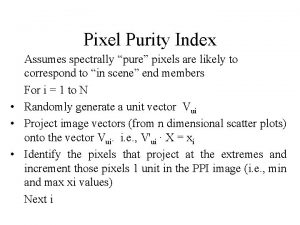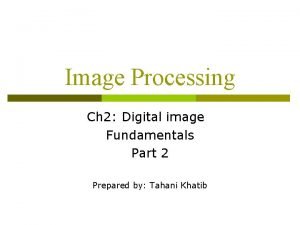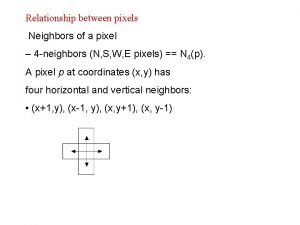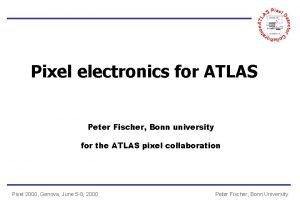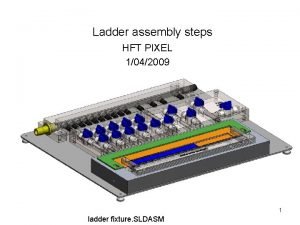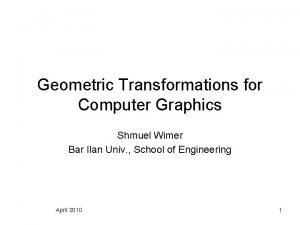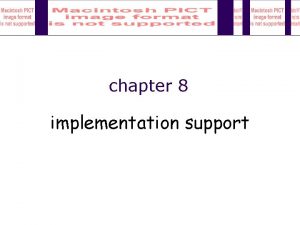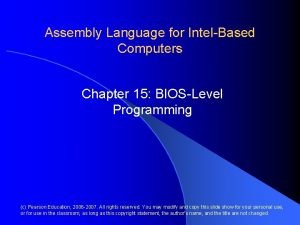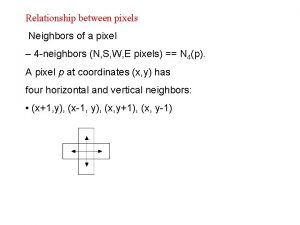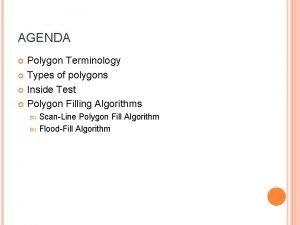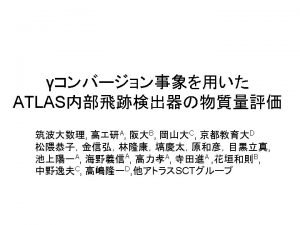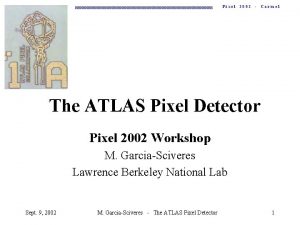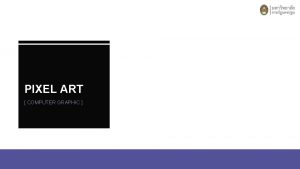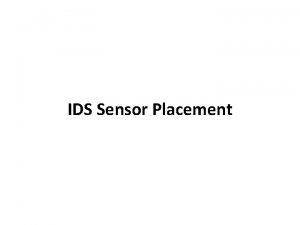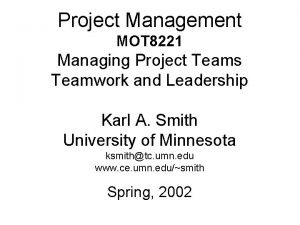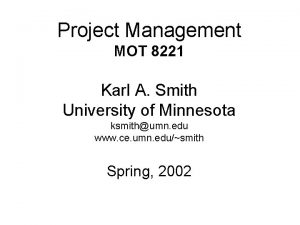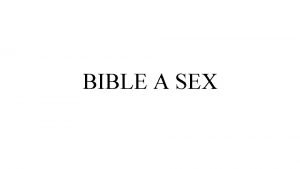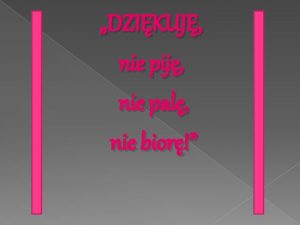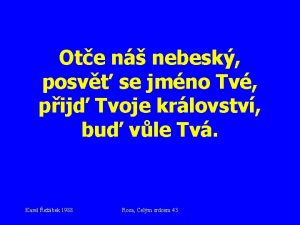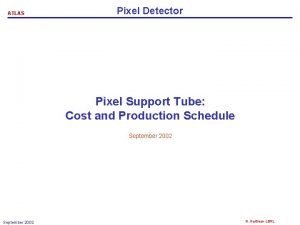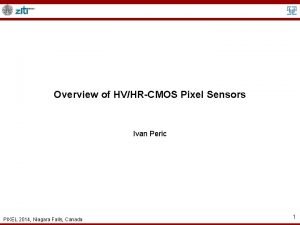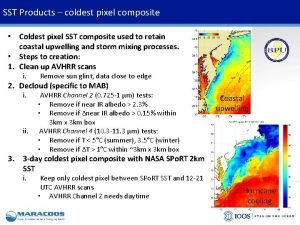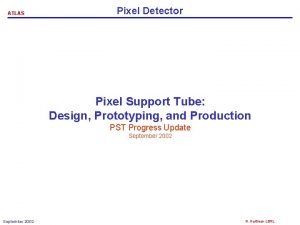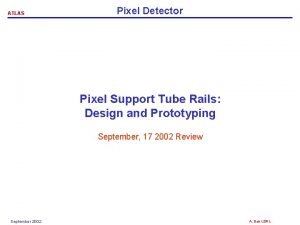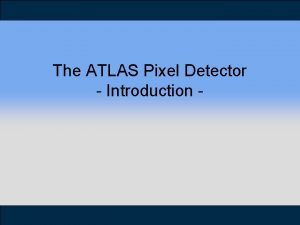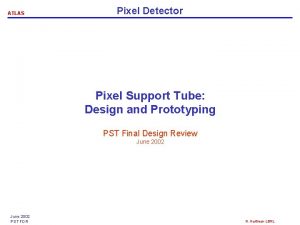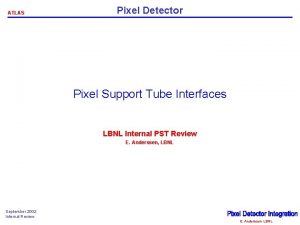P Paul XIGWCRTMIS 8221 5429 PIJ Pixel Placement
























- Slides: 24

P. Paul XIG/WCRT/M&IS 8*221 -5429 PIJ Pixel Placement System Simulation Peter Paul XIG/WCRT/M&IS October 24, 2002

P. Paul XIG/WCRT/M&IS 8*221 -5429 BIO Name: Peter Paul Organization: XIG/WCRT/M&IS Education (Degree/College): Ph. D. / Case Western Reserve University Area of Expertise: System Analysis Years of Experience: 8 Area of Focus: System Modeling & Simulation

P. Paul XIG/WCRT/M&IS 8*221 -5429 Other Contributors • Howard Mizes (XIG/WCRT) • Mojgan Rabbani (XIG/XTPO) • David Mantell (XIG/XTPO) • Dale Mashtare (XIG/WCRT) • Dan Costanza (XIG/WCRT) • Jeff Folkins (XIG/XTPO)

P. Paul XIG/WCRT/M&IS 8*221 -5429 Outline • PIJ Pixel Registration Problem Description • System Model Description • Results I: Simulating a set of Nominal Halftones • Results II: Analyzing the X-Interlace Defect • Summary & Next Steps

P. Paul XIG/WCRT/M&IS 8*221 -5429 Many Simultaneous Operations to Achieve High Productivity Configuration of Print Heads on Staggered Full Width Arrays (SFWA) System Architecture Cross Process Direction (X-Direction) PH 0/1 PH 0/0 SFWA 1 Motor 1 PH 1/0 Process Direction (Y-Direction) SFWA 0 Motor 0 Print Head Mapping onto Paper Cross Process Direction (X-Direction) Lead Edge PH 1/1 PH 0/1 PH 1/0 PH 0/0 Process Direction (Y-Direction) Paper Trail Edge Simultaneous Operations: 1. Heat & Register Paper 2. Lay layer of Oil on Drum 3. Build Image on Drum (6 Revs) by Indexing SFWAs on 4. Engage Transfix Roll on 6 th Rev (while Imaging) 5. Transfer Ink to Paper 6. Strip Paper from Drum 7. Fuse Ink to Paper

P. Paul XIG/WCRT/M&IS 8*221 -5429 SFWAs must be Indexed to Achieve Desired Cross-Process Direction Print Resolution Print Head Nozzle Configuration of Print Heads on Staggered Full Width Arrays (SFWA) 57 Cols Motor 0 PH 0/1 PH 0/0 SFWA 1 Motor 1 PH 1/0 Process Direction (Y-Direction) SFWA 0 16 Rows Cross Process Direction (X-Direction) 18 Pixels (600 DPI) Paper Trail Edge Lead Edge PH 1/1 PH 0/1 PH 1/0 PH 0/0 75 npi 1 Print Head X-Direction: 450 DPI Produced by Indexing the SFWAs 6 Times Y-Direction: 600 DPI Produced by Firing Rate of PHs & Motion o

P. Paul XIG/WCRT/M&IS 8*221 -5429 Nozzles are Interlaced to Avoid Localizing Defects from Nozzle Placement & TTD Errors Print Head: Print 1 Pass Head: Print 2 Head: Pass 3 Head: 4 Pass Print Head: 5 Pass 6 Print. Pass Head: N-5 N-3 N-2 NN-1 NN+2 N+1 N+2 N+3 N+4 N-2 N-4 N-1 N-4 N-2 NN-1 N+1 NN+2 N+3 N+1 N+4 N+2 N+5 N+3 N+6 N+4 N+7 N+5 N-3 N-4 N-2 N-3 N-1 N-2 N N-3 N-1 N+1 NN+2 N+1 N+3 N+2 N+3 N+4 N+5 N+6 Cross Process Direction (X-Direction) Motor 0 PH 0/1 PH 0/0 SFWA 1 Motor 1 Paper Trail Edge PH 1/1 PH 1/0 Process Direction (Y-Direction) SFWA 0 PH 1/1 PH 0/1 PH 1/0 PH 0/0 Patch Lead Edge Remarks: • Nozzles are Interlaced such that Adjacent Pixels are not made by the same Nozzle • TTD = Ink Drop flight “Time to Drum”, note Flat Nozzle Plane Ejecting onto Curved Drum Surface • 450 dpi X-Direction Pixels • 75 npi Single Color Nozzles: 6 Index Positions • 25 Pixel Wide Patch Example • 8 Nozzles Participate in making the Patch • Uni-Directional Interlace • Discrete Index Positions, Not Barber-Poling • Interlace is described by moves (in Pixels): 4 -4 -3 -4 -4 • Fill/Pass Mapping Sequence is: 1 -6 -3 -5 -2 -4 -1 • Many Other Interlaces are Possible

Modular Print Heads and Print Process Create System with Many Pixel Registration Error Sources P. Paul XIG/WCRT/M&IS 8*221 -5429 System SFWAs Print Heads Cross Process Direction (X-Direction) 57 Cols 16 Rows Motor 0 PH 0/1 PH 0/0 SFWA 1 18 Pixels (600 DPI) Motor 1 75 npi PH 1/1 PH 1/0 Process Direction (Y-Direction) SFWA 0 1 Print Head Identified Error Sources Ink-Drum Positioning: Nozzle-Drum Timing: • Nozzle Ejection Direction • Nozzle Location on Print Head • Print Head – SFWA Alignment • SFWA – Frame Positioning • Drum – Frame Alignment • SFWA – SFWA Positioning • Vibrations • Thermal Effects • Coalescence of Drops on Drum • Ink Drop Velocity (TTD) • Drum Angular Velocity • Nozzle Timing (Reflex Printing) • Nozzle Row-Row Ejection Timing • PH-PH Ejection Timing • Rev-Rev Ejection Timing

P. Paul XIG/WCRT/M&IS 8*221 -5429 Outline • PIJ Pixel Registration Problem Description • System Model Description • Results I: Simulating a set of Nominal Halftones • Results II: Analyzing the X-Interlace Defect • Summary & Next Steps

Matlab Pixel Placement System Simulator aids Requirements Generation and Analysis Process P. Paul XIG/WCRT/M&IS 8*221 -5429 MATLAB Environment Monte Carlo Input Parameters Pixel Center Generator Digital Image Generator IQAF Tools Geometric Reg Quantification Hi-Res Printer Image Generation System Error Sources Ink-Drum Positioning: Nozzle-Drum Timing: • Nozzle Ejection Direction • Ink Drop Velocity (TTD) • Nozzle Location on Print Head • Drum Angular Velocity • Print Head – SFWA Alignment • Nozzle Timing (Reflex Printing) • SFWA – Frame Positioning • Nozzle Row-Row Ejection Timing • Drum – Frame Alignment • PH-PH Ejection Timing • SFWA – SFWA Positioning • Rev-Rev Ejection Timing • Vibrations • Thermal Effects • Coalescence of Drops on Drum Pixel Reg / IQ Evaluation Input Image As TIFF Simulated Image Generator Output as TIFF Human Observation Current Features • Error Sources (to left in Blue) • “Swizzle” Algorithm to map Pixels to Nozzles & Time • Constant Dot Size, easily adjustable per dot • 20% Area Coverage 500 x 250 Pixel Image takes ~5 min on 366 Mhz PII 192 MB Laptop (3600 x 3600 DPI Image Generation is the long p

Determining Pixel Placement involves Solving a Simple Quadratic Equation for each Nozzle Drum Intersection Point P. Paul XIG/WCRT/M&IS 8*221 -5429 Drum Intersection Point (unknown “a”) Cylindrical Drum Constraint Print H z D ru m ead y x. Drum Local Inertial Coordinate System Quadratic Equation in “a” How to find n_vec & q_hat? Use Appropriate Coordinate Transformations Note: • Error Terms are in the R’s, n_PH, and q_PH • Small Angle Approximations are valid for Roll, Pitch, Yaw • Cos(th) = 1, Sin(th) = th • Order of Roll, Pitch, Yaw not important

Block Diagram of Simulation & Experimentation Environment P. Paul XIG/WCRT/M&IS 8*221 -5429 Geometry & Timing Errors Digital Image Kinematics Model / Sim Drop Errors Pixel Centers • n = 1, 2, …, Npixels • X_paper(n), Y_paper(n) • Nozzle(n) • Drum. Hit_Time(n) L* Generation Image. Setter File Generator P 850/SD 850 File Generator Virtual Prints • L*(X, Y) on Paper • YN Model • 3600 dpi @ 8 bits • Derived Numerical Metrics Hard Copy • 3600 dpi @ 1 bit • 7 um dots, reliable 14 um isolated dots • 4. 0 OD Hard Copy • Multiple Images @ 600 dpi • Micro-Adjust X & Y & Drop Vol • ~120 um & ~80 um Nominal Dot Size • 450 x 600 & Higher Available through multiple images • Screen “bypass” available using bitmap “image” in ps

P. Paul XIG/WCRT/M&IS 8*221 -5429 Outline • PIJ Pixel Registration Problem Description • System Model Description • Results I: Simulating a set of Nominal Halftones • Results II: Analyzing the X-Interlace Defect • Summary & Next Steps

P. Paul XIG/WCRT/M&IS 8*221 -5429 Example Inputs & Outputs of Simulation & Experimentation Environment Outputs P 850 Printer Scanner Reflectance Measured L* Printer Simulation Estimated L* Hi-Res Printer Digital Image Input Hi-Res Printer Target

H. Mizes’ Model for empirically fitting Microscopic Mass distribution to L* L*(x, y) pixel (x, y) L 0 including Lp Ly average P. Paul XIG/WCRT/M&IS 8*221 -5429 is the calculated “microscopic” L* for the is the L* contribution from the paper the Yule-Nielsen effect is the L* of the base paper is the linear “darkening” of the paper with mass of ink in a halftone patch is the average ink mass in the halftone m_bar patch L 1 is the L* of a solid patch made with this ink mb(x, y) is the “microscopic” mass of ink on pixel (x, y) on paper arks: L 2 is the “mass constant” which represents • As ink mass goes to zero, L*(x, y) goes to L* of thehow base paper quickly • As ink mass gets large, L*(x, y) goes to L* of solid ink patch the effect of added mass makes L* reach its final value ting Procedure: set of Halftone Patches re “microscopic” L* of each Patch on an L* calibrated hi resolution scanner (or camera) to determine lhs of the fitting e ram the pixel L* for each patch to determine how the “white” pixels “darken” with added average mass to determin re L* of the paper to determine Lp re L* of solid patch to determine L 1 te this same set of Halftone Patches to determine m_bar and mb(x, y) cally fit parameter L 2 to the data the model parameters through an optimization procedure

Results using empirical L* model: Simulation matches Physical Print for low density halftones 1 mm Measured L* from P 850 Print Simulated L* P. Paul XIG/WCRT/M&IS 8*221 -5429

P. Paul XIG/WCRT/M&IS 8*221 -5429 Dark patches show a graininess mismatch 4 mm Measured L* from P 850 Print Simulated L*

P. Paul XIG/WCRT/M&IS 8*221 -5429 Use IQAF to Quantify Graininess Mismatch in a Quantitative Manner MATLAB Environment Monte Carlo Input Parameters Pixel Center Generator Digital Image Generator IQAF Tools Geometric Reg Quantification Hi-Res Printer Image Generation Human Observation Pixel Reg / IQ Evaluation Input Image As TIFF Simulated Image Generator Output as TIFF

IQAF Graininess Metric: Reveals that Simulation Underestimates Graininess of Physical Prints P. Paul XIG/WCRT/M&IS 8*221 -5429 Measurements by Dale Mashtare Relevant Unmodeled Physical Phenomenon: Have been experimentally • Ink Drop Coalescence on Drum measured and modeled, currently in the processing • Per Ejection Nozzle Directionality Variation folding the results • Per Ejection Ink Drop Mass Variationinto the simulation…

P. Paul XIG/WCRT/M&IS 8*221 -5429 Outline • PIJ Pixel Registration Problem Description • System Model Description • Results I: Simulating a set of Nominal Halftones • Results II: Analyzing the X-Interlace Defect • Summary & Next Steps

SFWA – Frame Positioning Error Example: Errors has Periodicity of Nozzle Spacing P. Paul XIG/WCRT/M&IS 8*221 -5429 Cross Process Direction (X-Direction) Motor 0 PH 0/1 PH 0/0 SFWA 1 Motor 1 Paper Trail Edge PH 1/1 PH 1/0 Process Direction (Y-Direction) SFWA 0 PH 1/1 PH 0/1 PH 1/0 PH 0/0 Patch Lead Edge • SFWA Positioning Error on 2 nd Drum Revolution • 450 dpi Pixels • 75 npi Single Color Nozzles • 25 Pixel Wide Patch • 8 Nozzles Participate in making the Patch • Interlace is described by moves (in Pixels): 4 -4 -3 -4 -4 • Fill/Pass Sequence is: 1 -6 -3 -5 -2 -4 -1

P. Paul XIG/WCRT/M&IS 8*221 -5429 Use Image. Setter and Human Observers to Evaluate Simulation Output MATLAB Environment Monte Carlo Input Parameters Pixel Center Generator Digital Image Generator IQAF Tools Geometric Reg Quantification Hi-Res Printer Image Generation Human Observation Pixel Reg / IQ Evaluation Input Image As TIFF Simulated Image Generator Output as TIFF

Hard Copy from Simulation Output Qualitatively Matched Physical Prints for X-Interlace Defect P 850 Printer Scanner P. Paul XIG/WCRT/M&IS 8*221 -5429 Outputs Scanner Reflectance Printer Simulation Image Setter Target Digital Image Input See me to View Prints Hard Copy • 3600 dpi @ 1 bit • 7 um dots, reliable 14 um isolated dots • 4. 0 OD

P. Paul XIG/WCRT/M&IS 8*221 -5429 Summary & Next Steps • PIJ Pixel Registration Analysis Model Developed. • Qualitative and Relative Performance of the Model has been Validated. • Quantitative Validation points to more Physical Phenomenon that need to be included in the model. – Coalescence – Per Ejection Directionality & Mass Variation • Exercised on PIJ Program for analysis that cannot be performed experimentally (ex. Print Head Nozzle Spacing) & to confirm experimental data. • Solid Ink Printer modified to allow Hi-Res Output to be used as next Physical Output Device.
 Nie jedz i nie pij przy komputerze
Nie jedz i nie pij przy komputerze Pravda nebo pij
Pravda nebo pij Nie pij wody po zjedzeniu ryby
Nie pij wody po zjedzeniu ryby Nie jedz i nie pij przy komputerze
Nie jedz i nie pij przy komputerze Petra riedler
Petra riedler Micro pixel
Micro pixel Pixel aspect ratio
Pixel aspect ratio What is bitmap and pixmap in computer graphics
What is bitmap and pixmap in computer graphics Chart text
Chart text The distance between pixels p and q
The distance between pixels p and q 9thz
9thz Colour 23042008
Colour 23042008 Pixel shift
Pixel shift Qual tipo de filtro é o de canny?
Qual tipo de filtro é o de canny? Tera pixel
Tera pixel Pixel purity index is to determine
Pixel purity index is to determine For coordinates p(2,3) the 4 neighbors of pixel p are
For coordinates p(2,3) the 4 neighbors of pixel p are Relationship between pixels
Relationship between pixels Pixel electronics
Pixel electronics Pixel ladder
Pixel ladder Geometric transformations
Geometric transformations Windows architecture
Windows architecture Assembly language draw pixel
Assembly language draw pixel Basic relationships between pixels
Basic relationships between pixels Identify a method for testing a pixel inside polygon or not
Identify a method for testing a pixel inside polygon or not

